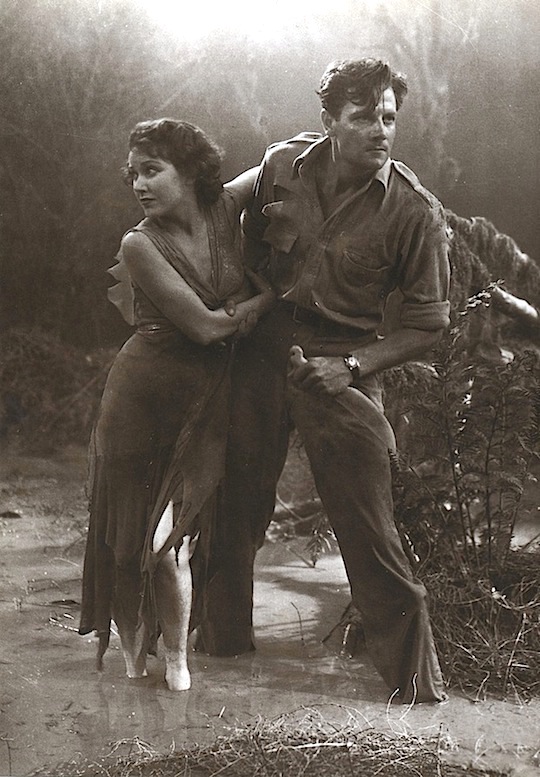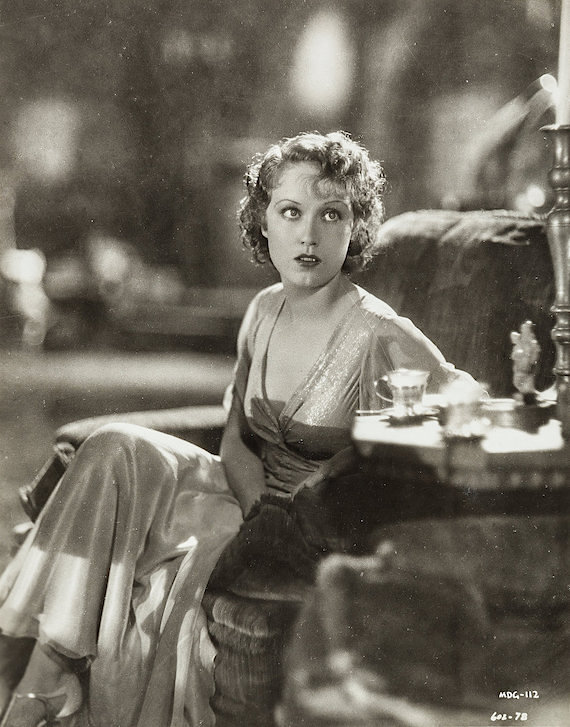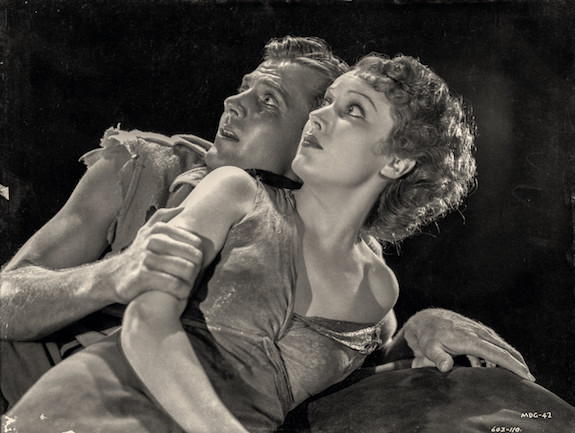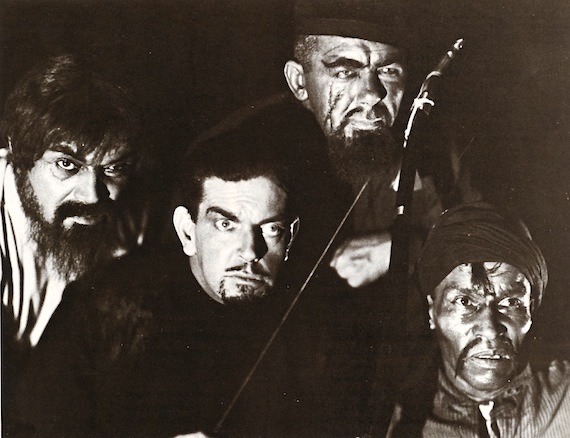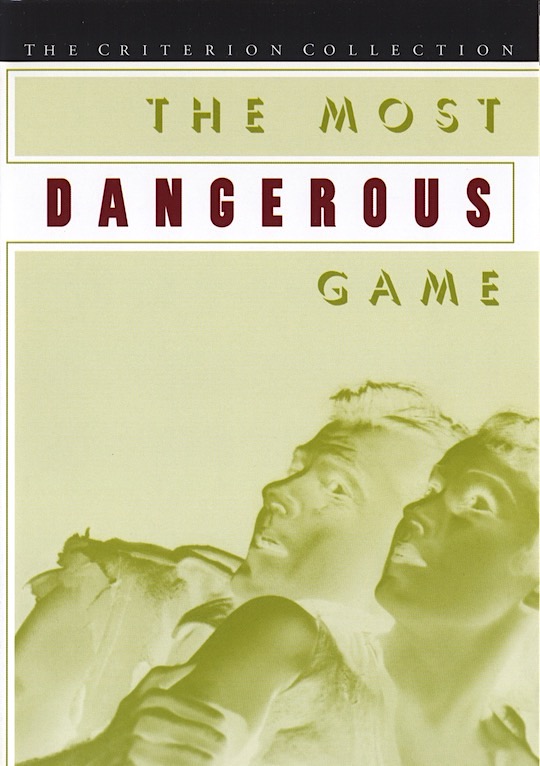Webster's defines HORROR as: ( n. ) 1. the strong feeling caused by something frightful or shocking; terror and repugnance. 2. strong dislike or aversion. 3. the quality of causing horror. 4. something that causes horror.Webster's defines ADVENTURE as: ( n. ) 1. the encountering of danger. 2. a daring, hazardous undertaking. 3. an unusual, stirring experience, often of a romantic nature. 4. a liking for danger, excitement, etc.
MY INTEREST in horror movies has less to do with their actual elements of terror and fear and more about their innate ability to create adventurous environments around those elements. It's that requisite search for adventure that has pushed me to watch, or sample, hundreds of horror films throughout my lifetime, and often to my own detriment (most horror films are crap-awful). But I will admit to enjoying the often brilliant performances of the many unsung actors that populate the field, as well as basking in the incredible milieu, robust atmosphere and scariness that is so intrinsic to the genre's popularity.
One of my favorite "horror-adventure" films from the early days of Hollywood is The Most Dangerous Game, a pre-Code, RKO Radio Picture production released in 1932 (62 minutes, black & white).
Ernest B. Schoedsack and Irving Pichel, of King Kong fame, were the film's co-directors. The producer was Merian C. Cooper. The film was edited by Archie Marshek and the cinematography was handled by Henry W. Gerrard. The screenplay was written by James Ashmore Creelman and the score was produced by Max Steiner.
Fay Wray and Joel McCrea were cast as leads in The Most Dangerous Game, which also starred Leslie Banks and Robert Armstrong. Wray of course would be destined for ultimate remembrance one year later for her iconic role as Ann Darrow in King Kong, while McCrea would become, after effectively starring in such classic films as Foreign Correspondent and Union Pacific, one of Hollywood's most forthright, leading men, especially in Westerns.
Their characters Eve Trowbridge and Sanger "Bob" Rainsford are shipwrecked on a remote island, inhabited by the fiendish megalomaniac Count Zaroff (played melodramatically but effectively by the great English stage actor Leslie Banks), who forces them to engage in a sadistic hunt with the two of them as his human prey. The hunt, aided by Zaroff's loyal henchmen, becomes a testosterone fueled duel in which the world class hunter Rainsford's honor-bound rules are challenged in the most extreme way. Eve, although unaware of it during the ordeal, will be the compulsory prize to the successor.
Their characters Eve Trowbridge and Sanger "Bob" Rainsford are shipwrecked on a remote island, inhabited by the fiendish megalomaniac Count Zaroff (played melodramatically but effectively by the great English stage actor Leslie Banks), who forces them to engage in a sadistic hunt with the two of them as his human prey. The hunt, aided by Zaroff's loyal henchmen, becomes a testosterone fueled duel in which the world class hunter Rainsford's honor-bound rules are challenged in the most extreme way. Eve, although unaware of it during the ordeal, will be the compulsory prize to the successor.
It's
been stated that The Most Dangerous Game represents American isolationist fears during
the Great Depression, with Zaroff's führer-like figure symbolizing
decadent Europe. That expositor does feel accurate (Banks would have made an incredible on-screen Hitler), but even with
that political conflagration in place I see this movie only as a suspenseful adventure story, yet one tinged with dark, underlying Sadeian
horror.
The Most Dangerous Game is based on a short story of the same name by Richard Connell (1893-1949). It was originally published in Colliers magazine on January 19, 1924, with illustrations by the American born artist Wilmot Emerton Heitland (1893-1969). Connell's yarn won the O'Henry Memorial Award for short fiction the year it was published. Connell himself was a prolific short story writer, credited with over 300 stories, many of them published in either Collier's or The Saturday Evening Post. He also wrote more than a dozen screenplays (he was a contributing screenwriter on The Most Dangerous Game), and he was nominated for an Academy Award in 1942 for Best Original Story for the movie Meet John Doe (1941), based on his 1922 story "A Reputation."
Connell's now classic story has been reprinted at least sixteen times in various English language anthologies, but illustrated only twice on an actual book cover. The first was on Berkley's 1957 paperback anthology, The Most Dangerous Game and Other Stories of Adventure, with cover art by Mel Crair, and the second on Random House's 1967 hardcover anthology Alfred Hitchcock's Spellbinders in Suspense, with cover art and interior illustrations by Harold Isen.
I was eight or nine years old when I first saw The Most Dangerous Game broadcast on television, and I loved it. Even now, a half century later, its legacy of adventure, horror and suspense hasn't diminished at all with me, and when I began assembling my list of Top-Ten favorite movies for this posting I felt compelled to include it, along with several other films of the same ilk. They are, by their release dates, as follows:
- The Most Dangerous Game (1932)
- King Kong (1933)
- Creature from the Black Lagoon (1954)
- Curse of the Demon (1958)
- The Mysterious Island (1961)
- The Haunting (1963)
- Jaws (1975)
- Alien (1979)
- The Thing (1982)
- Aliens (1986)
By strict definition all but one of these films, that being The Most Dangerous Game, are "Monster Movies", a sub-genre within horror which seems to incorporate adventure into itself almost by virtue of its very nature.
However, if I could be allowed an alternative list it might look like this:
However, if I could be allowed an alternative list it might look like this:
- Lost Horizon (1937)
- The Wizard of Oz (1939)
- Casablanca (1942)
- 7th Voyage of Sinbad (1958)
- Dersu Uzala (1975)
- Star Wars (Episodes IV, V, VI; 1977, 1980, 1983)
- The Road Warrior (1981)
- Raiders of the Lost Ark (1981)
- Ofelas aka Pathfinder (1987)
- The Last of the Mohicans (1992)
Most of the films on my secondary list are not "monster" related per se, but they are great adventure stories, each and every one. And yet great films exist even outside of the genres that I so blatantly favor, and I could be swayed to include almost any film from the 1970s, be it comedy, drama, crime, exploitation, historical, fantasy or science-fiction. The 1970s was, arguably, the greatest decade for movies ever, and any intelligent person shouldn't have to look anywhere else to find a favorite film representation, and one that will stand the test of time. Go back even further to 1968's 2001: A Space Odyssey, and then cap it off with 1982's The Thing, and what you have in between is simply undeniable in its importance as cultural, cinematic entertainment. I even have a soft spot for 1979's terribly underappreciated More American Graffiti.
But seriously, how can anyone compile a Top-Ten list and then stick with it for all time? Isn't our favorite movie merely the last great one we've seen, or re-seen? If I re-watch any of Hitchcock's best films again, Rear Window (1954), Vertigo (1958) and Psycho (1960), I'm apt to make a change in my top-ten. Perhaps my list should be expanded to include no less than 100 titles. After all, entertaining films, in any category, will always have an inherent ability to influence our opinion, even if our initial love of the medium began with a specific genre amalgamation.
1999 Criterion Collection DVD Liner Art. Designer(s) unknown.
2007 Legend Films DVD Liner Art. Designer(s) Unknown.
2012 Flicker Alley Blu-Ray Liner Art. Designer(s) unknown.
* * * * *
MY TEN FAVORITE FILMS OF ALL TIME (with comments):
The Most Dangerous Game - RKO Pictures, 1932, b&w, 62 minutes (poster artist unknown). It's amazing how cigarettes were infused into every Golden Age film, even their poster art. Heck, back then they were infused in every aspect of adult life, and sadly too because for many smokers it resulted in bad health and premature death. Leslie Banks was a smoker, and died of a stroke while walking at the age of 61. Was it the cigarettes?
King Kong - RKO Pictures, 1933, b&w, 100 minutes (poster artist unknown). Yes, I've read all about the supposed symbolism, metaphors and hidden meanings that surround King Kong like the clouds around Skull Island. It's been examined in considerable detail in any number of books including my favorite Kong tome, King Kong Cometh (Plexus, 2005, edited by Paul A. Woods). But when the last reel ends and the lights come on King Kong is still just a "monster movie," and nothing more. Though it is, and always will be, the "Biggest Daddy Of Them All"!
Creature From the Black Lagoon - Universal Pictures, 1954, b&w, 80 minutes (Note: this particular poster art has been erroneously credited to Reynold Brown but it is actually a studio made synthesis). Would Creature From the Black Lagoon have been better off made in color? Yes, of course--but it is what it was--and even if someone were to remake it in color with computer generated effects it would not necessarily be an improvement. Because, after all, nobody today can fill Richard Carlson's or Richard Denning's swimming trunks (or Julia Adams's, for that matter), and, unlike CG effects, a man in a rubber monster suit is still a very real thing. But if they eliminated those annoying trumpet blasts every time the creature reared its magnificent head I would definitely be on board for a remake.
Curse of the Demon - Columbia Pictures, 1957, b&w, 82 minutes (poster artist unknown). I've always loved this supernatural flick. It has so many special moments that to mention even one would constitute a spoiler. However, the producer and director were split on whether to have an actual appearance of the demon during the finale, but the producer prevailed, hence the not very scary giant demon head floating in the air. What the producer didn't realize but the director did, is that when telling a supernatural tale less can actually amount to more.
Mysterious Island - Columbia Pictures, 1961, color, 101 minutes (poster artist unknown). A Civil War prison breakout, a storm-driven balloon ride across the Atlantic ocean, a fantastic looking deserted island, a rumbling volcano, a fantastic atomic submarine, an eccentric captain, beautiful Beth Rogan, and yes... some GIANT-ASS creatures! Okay, now that I've mentioned a few of the film's most memorable mentionables, I need to be honest; Mysterious Island is not a perfect movie. No movie ever is or ever has been. It barely rises above two out of five stars and it's opening scenes look cheap, jittery, and are poorly edited--but when you're a kid seeing it on the big screen for the first time it's about as perfect as perfect can be.
The Haunting - Metro Goldwyn Mayer, 1963, b&w, 114 minutes (poster artist unknown). When I was a kid I thought Julie Harris' performance as the psychologically fragile Eleanor was so over the top that it ruined the movie. But behind adult eyes I've changed my mind. Now I believe she is the film's greatest asset, notwithstanding its good direction, cinematography, script, special effects, cast and source material (Shirley Jackson's acclaimed 1959 gothic novel The Haunting of Hill House).
Jaws (Universal Pictures, 1975, color, 124 minutes (poster art by Roger Kastel). The first time I swam in the ocean was two summers after Jaws opened in theaters. My brother Gary and I went out beyond the kelp line, and then either he, or me, or both of us at the same time, began chanting the film's ominous score: dun tunt dun tunt dun tunt... Five minutes later, after completely unnerving ourselves like fools, we made a mad swim for shore and I for one have not been back in the water since--well, not over my knees anyway, ha ha! Jaws, as awesome as it is, is not the "greatest monster movie" ever made, that title belongs to King Kong, but it is the "best monster movie" ever made.
Alien (20th Century Fox, 1979, color, 116 minutes (poster art by Philip Gips). I love the fact that Alien, despite its clever tagline, and having the most unique visual design of any SF film of the 20th century, is really at heart just a good old fashion horror movie. Boo!
The Thing (Universal Pictures, 1982, color, 109 minutes (poster art by Drew Struzan). John Carpenter's remake of the 1951 film The Thing, drew its inspiration not from the film, but from the original source material, the actual short story by John W. Campbell, which by itself, is one of the scariest short stories ever written. That, plus a great cast, great direction, great score, great location filming and those wild special effects by the incredibly brilliant Rob Bottin, are why this Thing should be in everyone's Top-Ten list.
Aliens (20th Century Fox, 1986, color, 137 minutes (poster designer unknown). Aliens proved that in the modern world you don't have to have muscles or be a man to be strong and resilient.
* * * * *
MY ALTERNATE TEN FAVORITE FILMS OF ALL TIME (with comments):
Lost Horizon (Columbia Pictures, 1937, b&w, 132 minutes (poster art by James Montgomery Flagg). Cost overruns, filming delays; five separate shooting locations; excessive time spent recording even the shortest of scenes; black & white cinematography when color was warranted; a major cast member being replaced not once, not twice, but three times; 1.1 million feet of film shot; and a 3 1/2 half hour preview (cut from 6 hours) that had many audience members walking out and the rest laughing at sequences intended to be serious. All of that would have anyone think that Lost Horizon was destined to be a flop. So how did just the opposite happen and Lost Horizon become a cinematic classic? Well, for one, the source material, James Hilton’s magnificent adventure novel; and two, director Frank Capra himself, who made extensive cuts and reshot entire scenes to place more emphasis on "the growing desperation of the world situation at the time”; and three, studio head Harry Cohn, who intervened and edited the film personally, cutting it down even more to 132 minutes. This new, slimmed down version was met with immediate praise, one critic calling it one of the 10 best films of the year. I say it’s even better than that.
The Wizard of Oz (MGM, 1939, color and b&w, 101 minutes; poster art by Al Hirschfeld). According to the U.S. Library of Congress, The Wizard of Oz is the most seen film in movie history. That pretty much sums up its value, but that doesn't mean that half of the viewing public isn't still stupid, because they are; Don the Con proved that beyond a doubt. But I digress. What's really amazing about TWOZ is that it is a fantasy and Hollywood has always had a difficult time making really good fantasy movies. Go ahead, just try and name five fantasy films that you would be willing to watch more than once. Not so easy to do, is it?
Casablanca (Warner Bros., 1942, b&w, 102 minutes; poster designer unknown). Casablanca premiered in November, 1942, but it was not expected to stand out among the films produced that year so its nationwide release was delayed until January of 1943--or at least that's my interpretation of events. Its initial run was less than stellar, and yet it went on to win the Best Picture and Best Director awards at the 16th Academy Awards. Old folks like me are convinced it’s an enduring classic, but young folks might not agree, at least they don't seem much interested in black & white films anymore, so its legacy could be in danger, which is a shame because young folks are in effect denying themselves a chance to see what might be the most significant film ever made in Hollywood.
The 7th Voyage of Sinbad (Columbia Pictures, 1958, color, 88 minutes; poster art by Studio Brini). Jason and the Argonauts was Ray Harryhausen’s own favorite from among the films that featured his unique Dynamation process. Actor Tom Hanks regarded it as “the greatest film of all time.” So why choose The 7th Voyage of Sinbad over Jason and the Argonauts? Two reasons: the character Sinbad himself, the coolest captain to ever command a sea-vessel, and Kerwin Mathews, the most convincing actor to ever play the titular hero (and the most handsome, even weathering Guy Williams who came later). None of the other Sinbad actors could measure up to the swashbuckling Mathews; not Douglas Fairbanks Jr., not Dale Robertson, not John Phillip Law, not Robert Malcolm, not Patrick Wayne, not Manu Bennett, not Patrick Muldoon, and especially not Lou Ferrigno (although as bad cinema his Sinbad of the Seven Seas was pretty darn good!).
Dersu Uzala (Nihon Herald Eiga, 1975, color, 144 minutes; poster art by Averado Ciriello). I doubt if an audience today would be willing to sit thru a nearly 2 1/2 hour movie about a small group of Russian surveyors and their native Goldi guide battling hardships and danger in the rugged wilderness of Far East Russia. But back in the late 1970s I was willing to do so, after my brother Jim insisted that Dersu Uzala was not only Akira Kurosawa’s best film (remember Seven Samurai?), but one of the best films ever made. And man was he right! Just don’t expect to see the same scene that’s on the poster play out on the screen because the poster is an blatant exaggeration, yet one made with good intentions, which is to get your butt in the theater!
Star Wars, Episodes IV, V, VI (20th Century Fox, 1977, 1980, 1983, color, 121 minutes, 124 minutes, 132 minutes; poster art in descending order by Tom Chantrell, Roger Kastel, and Kazuhiko Sanu). I saw Star Wars on opening day at a matinee with my brother Gary (Wednesday, May 25, 1977). When the end credits finally rolled we both looked at each other, smiled, and then shrugged. Sure, we were impressed with most of what we had seen, but being serious SF guys, not with all of it. But Star Wars grew into something that neither of us could have predicted that afternoon--a motion picture phenomenon. We expected it to be a hit, but WOW, we had no idea the impact it would have nationally or even globally. The movie turned more kids into SF fans than any movie that came before it, or for that matter, any TV show, book, game or toy that came before it. And while Star Wars, its two sequels, and its millions of fans, as culturally significant as they are, and indeed they are, have not been able to prevent any real tyranny from occurring here on earth, when George Lucas later subtitled the first film as “A New Hope,” he couldn’t have picked a better title if he had wanted to.
The Road Warrior (Warner Bros., 1982, color, 96 minutes; poster art by Commander). I saw The Road Warrior, known outside the US as Mad Max 2, three times in the theater. It was the coolest movie I had ever seen up until then. Its star, Mel Gibson, was cool too, and about the same age as I was. It was easy to project myself behind the wheel of his GT Falcon, spewing dust all over the outback. Years later of course we found out that in real life Gibson wasn't so cool. That's why it's so important, especially with movies and TV shows, to separate the art from the artist, or more specifically, the performance from the performer. Otherwise there wouldn't be much left for us to watch that didn't leave us with disdain.
Pathfinder aka Ofelas (Carolco Pictures, 1987, color, 86 minutes; poster designer unknown). Pathfinder is a veracious historical adventure film about a young man's violent and heroic rite of passage in the year 1000 A.D. in northern Scandinavia. The story is based entirely on the legend of The Pathfinder, an ancient folktale of the Sami people of Lapland. I saw this movie first on VHS, then DVD, but never in a theater. But, because every celluloid frame is filled with stunning snowscapes, remarkable action sequences, authentic period detail, and distinctive actors and extras, I can’t wait for it to have an art-house revival. I consider it superior film-making on almost every level. I think you will you too.
The Last of the Mohicans (20th Century Fox, 1992, color, 112 minutes; poster designer unknown). Before Michael Mann released his 1992 version of Last of the Mohicans, Hollywood seemed to struggle to recreate an accurate view of 18th century life in Eastern North America, whether it be before, during, and after the Revolutionary War. To be fair, it isn’t an easy period to visualize or audioize, and to do it right means not holding back on the lens of history: its rights and its wrongs, its beauty and its brutality. The original The Last of the Mohicans (1936) is a boyhood favorite and while far from being perfect still has much to recommend. Allegheny Uprising (1939) is a spirited affair but perhaps too spirited. Drums Along the Mohawk (1939) isn’t half bad, but then again it is half bad. I love Northwest Passage (1940), but it is more fantasy than anything else. Fort Ti (1953) can’t be saved even by the great George Montgomery. April Morning (1988) recreates the Battle of Lexington to good effect, and probably deserves more credit than I’m willing to give it. But Mann’s film changed everything, it was like going back in a time machine to witness the French and Indian War first hand. Mann got all the particulars right too: story adaptation, period detail, outdoor settings, casting; acting, dialogue, choreography and music score. Since 1992, whenever I am asked what my favorite movie is, I've always said it's The Last of the Mohicans. I still see no reason to say otherwise.
[Originally posted in 2008. © September, 2019, Jeffersen]


